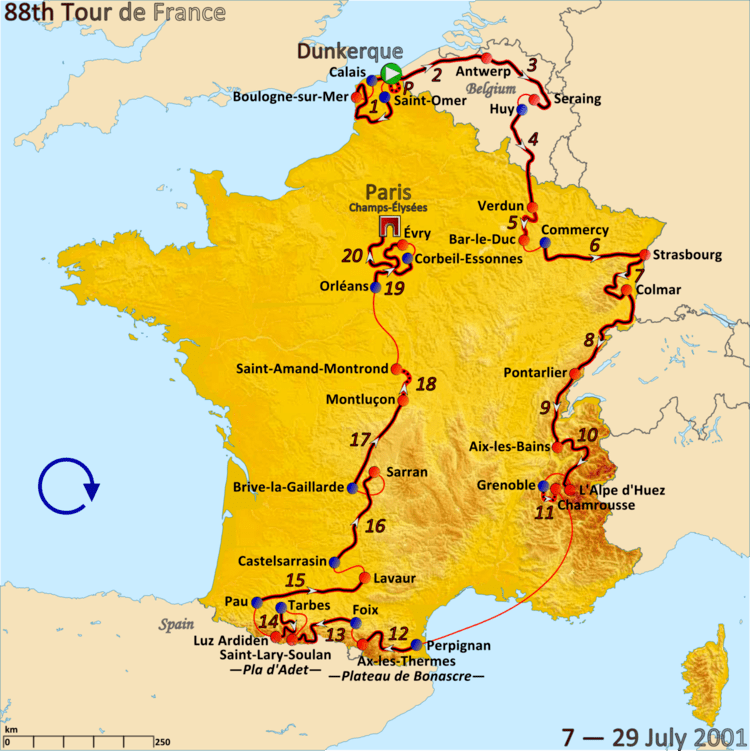Dates 7–29 July Distance 3,458 km (2,149 mi) | Stages 20 + Prologue Winning time 86h 17' 28" | |
 | ||
The 2001 Tour de France was a multiple-stage bicycle race held from 7 to 29 July, and the 88th edition of the Tour de France. It has no overall winner—although American cyclist Lance Armstrong originally won the event, the United States Anti-Doping Agency announced in August 2012 that they had disqualified Armstrong from all his results since 1998, including his seven Tour de France wins from 1999 to 2005. The verdict was subsequently confirmed by the Union Cycliste Internationale.
Contents
The race included a 67-kilometre-long (42 mi) team time trial, two individual time trials and five consecutive mountain-top finishing stages, the second of which was the Chamrousse special-category climb time trial. Thus, all the high-mountain stages were grouped consecutively, following the climbing time trial, with one rest day in between. France was ridden 'clockwise', so the Alps were visited before the Pyrenees. The Tour started in France but also visited Belgium in its first week. The ceremonial final stage finished at the Champs-Élysées in Paris, as is tradition. Erik Zabel won his record sixth consecutive points classification victory.
Teams
The organisers felt that the 2000 Tour de France did not include not enough French teams and consequently changed the selection procedure. U.S. Postal Service was selected because it included the winner of the previous edition, Lance Armstrong. Team Telekom was selected because it included the winner of the 2000 UCI Road World Cup, Erik Zabel). Mapei–Quick-Step was selected because it won the team classifications in the 2000 Giro d'Italia. Kelme–Costa Blanca was selected because it won the team classifications in both the 2000 Tour de France and 2000 Vuelta a España. A further twelve teams qualified based on the UCI ranking in the highest UCI division at the end of 2001, after compensating for transfers. Although initially it was announced that four wildcards would be given, the tour organisation decided to add five teams: In total, 21 teams participated, each with 9 cyclists, giving a total of 189 cyclists.
The teams entering the race were:
Qualified teams
Invited teams
Doping
Subsequent to Armstrong's statement to withdraw his fight against United States Anti-Doping Agency's (USADA) charges, on 24 August 2012, the USADA said it would ban Armstrong for life and stripped him of his record seven Tour de France titles. Later that day it was confirmed in a USADA statement that Armstrong was banned for life and would be disqualified from any and all competitive results obtained on and subsequent to 1 August 1998, including forfeiture of any medals, titles, winnings, finishes, points and prizes. On 22 October 2012, the Union Cycliste Internationale endorsed the USADA sanctions, and decided not to award victories to any other rider or upgrade other placings in any of the affected events.
Classification leadership
There were several classifications in the 2001 Tour de France. The most important was the general classification, calculated by adding each cyclist's finishing times in each stage. The cyclist with the least accumulated time was the race leader, identified by the yellow jersey; the winner of this classification is considered the winner of the Tour.
Additionally, there was a points classification, which awarded a green jersey. In this classification, cyclists got points for finishing among the best in a stage finish, or in intermediate sprints. The cyclist with the most points lead the classification and was identified with a green jersey.
There was also a mountains classification. The organisation had categorized some climbs as either hors catégorie, first, second, third, or fourth-category; points for this classification were won by the first cyclists to reach the top of these climbs, with more points available for the higher-categorized climbs. The cyclist with the most points lead the classification and was identified with a polkadot jersey.
The fourth individual classification was the young rider classification, which was marked by the white jersey. This was decided in the same way as the general classification, but only riders under 26 years of age were eligible.
For the team classification, the times of the best three cyclists per team on each stage were added; the leading team was the team with the lowest total time.
For the combativity award classification, a jury gave points after each stage to the cyclists they considered most combative. The cyclist with the most votes in all stages lead the classification.
